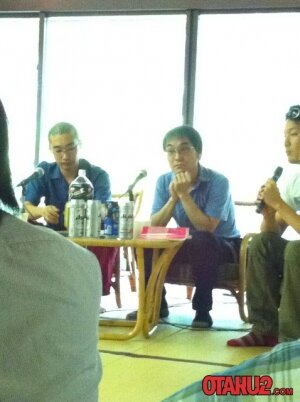 Filed under: Anime International Academic
Filed under: Anime International AcademicStorywriter Sato Dai is frustrated with Japanese anime
24.07.2010 by Patrick W. Galbraith
Sato Dai (佐藤大), storywriter for such anime hits as "Cowboy Bebop," participated at a roundtable discussion at a conference titled Cultural Typhoon held at Komazawa University in July 2010. Sato was joined by film director Tomita Katsuya and music journalist . They spoke for two hours on the topic of "Living in the City: Hip Hop, Anime, Housing Projects." While this was an academic conference and the panel was intended to address a wide range of issues, Sato spoke for most of the time, airing some of his deep concerns about the Japanese anime industry today.
Sato proved extremely skeptical in his views on anime. He stated that “we can’t do our own anime” and depend on subcontractors for in-between frames. These subcontractors are often not even aware of the product they are working on, and it loses its consistency. In Sato’s mind, this became obvious beginning with "Macross," when the “continuity between images was awful” but “we've been doing the same thing ever since.”
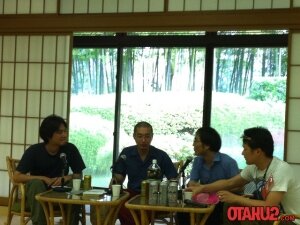
Because of the major dependence on Asian subcontractors, Sato outright denounced the idea of “Cool Japan.” Anime is not cool (he thinks of it as more resistive), and it is not really a product of Japan. He was critical of politicians and promoters using the concept of Cool Japan for their own purposes.
“Japanese pride is part of the national project,” he said, but it is only at the surface level. “Most people have no idea who makes it,” be they Japanese or Asians in general.
This reminded me a lot of what Arjun Appadurai calls “production fetishism.” He describes this as “an illusion created by contemporary transnational production loci, which masks translocal capital, transnational earning-flows, global management and often faraway workers (engaged in various kinds of high-tech putting-out operations) in the idiom and spectacle of local (sometimes even worker) control, national productivity and territorial sovereignty. … The locality (both in the sense of the local factory or site of production and in the extended sense of the nation-state) becomes a fetish which disguises the globally dispersed forces that actually drive the production process.” Seems like a pretty darn good description of “Japanese” anime.
He even accused people in the anime industry of refusing to teach Asian subcontractors special skills or how to craft stories because that would undermine the position of Japan in the production of anime. Non-Japanese are reduced to cheap mechanical labor, and aren’t invested in the work at all. Sato identified this as a major underlying problem with anime today. This aspect of the Japanese anime industry seemed to Sato to be fundamentally different from Hollywood, which made room for directors and skilled labors from all around the world.
In a very interesting assertion, Sato said that one of the reasons why China was a prime place to outsource anime is because educated, radical Chinese were denied access to good jobs and basically corralled into certain areas. These areas became something of an industrial core for Japanese anime because of this labor force that could draw the idiographic Chinese language (and ostensibly copy anime drawings), needed work and was concentrated together. Whether true or not, Sato told this story to demonstrate the exploitative practices and hierarchical nature of anime production.
Sato was upset with the lack of respect for stories in Japan. He pointed out that “Ergo Proxy,” for which he wrote the story, had DVD box sets around the world, but not in Japan. He also said that many anime fans dismissed “Eureka Seven” as a “Neon Genesis Evangelion” clone without even watching it. The story, setting and characters are totally different, but snap judgments were made based on images of a mysterious blue-haired girl with red eyes piloting a giant robot (both Ayanami Rei and Eureka fit the description). He wondered how much anime fans really are interested in close readings to generate information (the classic definition of otaku viewing practices since Okada Toshio). After all, few if any cared to think what the titles of episodes meant, why a certain mecha was called “Devil Fish” or even what the Summer of Love referenced. Sato clarified that this was homage to rave culture in Japan.
Sadly, he believes that fans are losing their media literacy – the ability to read narratives and stories and the meanings in the background.
As a storywriter, Sato had a big axe to grind about the place of the story in Japanese anime. He complained that his works are labeled “difficult-type” (muzukashii-kei), something like the opposite of “atmosphere type” (kuuki-kei) anime. The latter is the type where nothing happens, or there is no significant plot, narrative or development. They tend to focus on cute characters and be very popular with moe fans. Sato said guys like him get no work, even as “Hollywood rips off our ideas.”
He did not say that he disliked “atmosphere-type” works like “K-On!” – rather he likes the incredible designs. He also did not criticize fan service, because, just as many Japanese film directors came from the “pink movie” industry, many animators are coming from a background in erotic material (doujinshi, eroge or ero-anime/manga). Sexual desire is part of the creative drive. But he sees them as moving towards characters and wasting time seeing just how nice they can make the images and movements look. This undermines the special anime-like movements, the visual vocabulary, that came out limited TV anime in the 1970s. There is also the issue of dumbing anime down.
“No one wants to hear about NEET [the unemployed],” Sato said. “They’d rather watch a group of high school girls in a band asking, ‘How do I play this note?’” By this point, he was livid and practically spitting in disgust at these fans who “luv anime” (anime daichuki). “If we are always escaping from reality and real problems, when will we face them?”
The backgrounds based on real places are another similar problem. “It a drug for us” in the anime industry, Sato said. It boosts tourism and pleases fans. “When I see anime today, I realize that we have no pride left.”
Anime has become a “super establishment system,” where nothing can be changed. And the system is moving towards the model of Akihabara – the importance of characters, images, merchandise – which Sato saw as a perversion of its original idealism. It’s selling out. “Miyazaki Hayao was a communist,” Sato said, working himself into a rage. “He was fighting the system!”
Sato praised rap and hip hop because, to him, it looks like they are still underground and people don’t sell out. He equated manga with rap, because it takes less people to produce and authors/artists tend not to sell out. (To Sato, otaku and rappers are not that different. They focus their attention, and communicate through creation and in order to facilitate creation. The image that otaku are different than other youth groups, or are somehow better or worse than them, is just media hype.) Even if the commercial industry denies someone, there is doujinshi, or the “super indies.” Manga is where anime has traditionally drawn its stories and creativity, but the industry is becoming more reliant on it. As Sato sees it: “Manga is the last hold out. If that is lost, there will be no more anime.”
Listening to him describe it, Sato seems to be consciously fighting against trends in anime and trying to make strong, original stories. He seems to be making a sustained attack on kuuki-kei and sekai-kei stories, or stories where personal problems are equated with problems of the entire world, without the intervention of society or the state. He described “Ergo Proxy” and “Eden of the East” as anti-sekai-kei. Certainly social issues are at the heart of “Eden of the East.” Sato said he was in part inspired to write about the plight (apathy, poverty) of young Japanese because he was in Koenji when Amateur Rebellion (shiroto no ran) was using Matsumoto Hajime’s candidacy in the ward elections to “campaign” in front of the train station. This entailed live outdoor DJ and hip hop events, and chanting, “We will not work” (hatarakanee zo). The unemployed youth gathering in the abandoned mall in “Eden of the East” was a riff on “the living dead.” Going to the suburbs and seeing housing projects, Sato saw emptied out cities without energy, without young people, without a future.
Does anime have a future? Sato’s gloomy prediction is that anime will die out in Japan in a few decades. But he wants to keep on making it, because he does not want that to happen. “I am just working so that there will be a next project.”
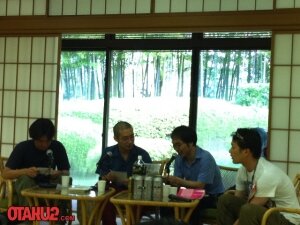
Comment on this article

24.10.2010 · Blog
Tokyo International Anime Fair in Akihabara
Well, the Tokyo Anime Fair Tokyo International Anime Fair has come and gone again. This time was the autumn addition, the "sister event" of...
09.09.2010 · Blog
K-On! Event in Akasaka
Coming towards the end of "K-On!" and honestly not a lot else has been on my mind. OK, so there are other great(er?) anime out there this...
24.07.2010 · Blog
Michael Arias, an American making anime
As part of the Summer Institute of Studies in Japanese Popular Culture, Temple University Japan Campus had a guest lecture by Michael Arias...
30.05.2010 · Blog
The Politics of Popular Culture
Temple University Japan will be holding two conferences on Japanese popular culture as part of the maid cafes. Each event is 1,000 yen,...
08.05.2010 · Reviews
'King of Thorn' film suffers from game-like delivery
Sci-fi survival drama develops in lurches
05.05.2010 · Reviews
'Trigun: Badlands Rumble' is just like old times
The wild west sci-fi thriller doesn't disappoint



















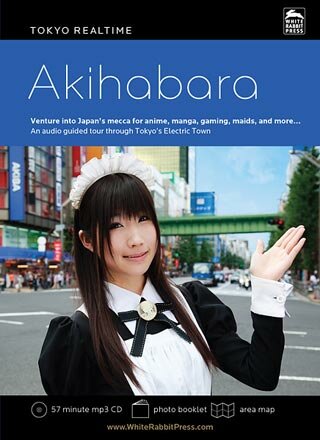
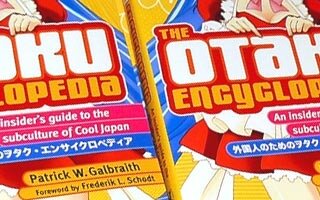


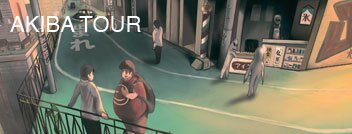
20 CommentsComment Page 1 of 3 1 2 3 >
no moe no die wrote on 04.11.2010:
I 1,000,000% agree alike the comments on mr.sato dai and banana fana!!!! moe?! tsk.. tsk.. ~get a life!!
jerry ku wrote on 25.10.2010:
Woah @ "Production fetishism"
I knew some academic must've come up with a term for what I often think about. I get so annoyed hearing about nationalistic pride in video games and anime and so forth.
I'll have to read this Appadurai guy's books!
I also thought it was really interesting to hear Sato Dai talk about outsourced anime work to China and South Korea, and how Japanese anime people may be purposefully keeping them out of the "old boys club" so to speak. It's pretty disturbing.
And what's this about Miyazaki being a communist? o_O
TJ wrote on 10.9.2010:
Everything Sato said was everything I have been feeling for a year now (besides being a Japanese market material. Not into 'patriotism', but the Japanese can get it done). Lately I have been feeling that recent up and coming anime are just in it for show. Nana is a classic, K-On! relies on appearances to gain fan base. Code Geass had a fantastic, genius story but it didn't need the constant fan service. Bleach is exciting for the creative weapons and battle scenes, but if you're looking for a story look no further than Eureka Seven. Eureka Seven is my favorite anime and I prefer it underground, calling it that because it is not as popular as FMA and TTGL (both are just as amazing).
My obsession with E7 started with Anemone's monolgue at ep. 48, which I thought Sato wrote (Yuuichi Nomura) and I got into his works. Away from that fact, from E7 I respected Dai Sato for how he keeps true to his story lines and his pop culture references and not for how far heads can sink into breasts. Dai Sato should create his own anime company ('Blue Japan' eh?) to make anime he sees fit, which would pleasure our minds as well. It would be like normal BONES tagged anime, but even better.
I wish I could talk to Sato...
Racel wrote on 08.9.2010:
sir dai sato please continue the eureka seven because i really want it so much ....
plzzzzzzzzzzzzz
wowow wrote on 16.8.2010:
great interview !
but i think...
now JAP anime focus on kawaii Charactor more than story line...
beacuse it's easy to make money than complex story
that mean DAI SATO san one of the grandmaster keyman
of seconds generation JAP anime in story writer position
his job is on fire !!
(DAI SATO san is same/equal level as KATSUHIRO OTOMO in
sub company of SUNRISE if u have no idea)
Steffen wrote on 07.8.2010:
I have to agree with almost everything Dai-san said. Maybe the industry collapsing will be a good thing though, people need to face reality while creating and consuming anime. What use is MONSTER or especially EVANGELION, which to me is still the best series ever, or their characters when people who don't know themselves are supposed to feel for them? More effort on the consumer side is needed if the stupifying machine is supposed to stop!
Travis Knotts wrote on 04.8.2010:
I agree with Sato too i'm the kind of 18 year-old that falls in love with intricate and creative anime! Unlike some people who dismissed Eureka Seven, I think it rocked, to be honest the ending of Episode 50 left me in tears and repeatedly saying "what a great ending"! To me Neon Genesis totally and uturly sucks when you compare it to Eureka Seven! And i'm hoping Sato makes onother chapter or a Part 2 of Eureka Seven, you know one that shows what actually happened to Renton and Eureka after they became one, what happended to the scub coral, what happended to Axel Thurston and his three grandchildren, he got from Renton!!!! A second series that fills in all the gaps and ties all the loose ends!!!!! And if you compare the mecha in Neon genesis to the mecha in Eureka Seven, Eureka Seven had LFO's that reacted to the pilot's will and in turn changed it's form like when the Nirvash awoke into it's true form when Renton called out Eurka's Name!!! NEON GENESIS SUUUUUCKKS!!!!! They don't have Mechs that can change form like the Nirvosh TypeZERO can!! And that's the Truth!!!! I HONESTLY FELL IN LOVE WITH EUREKA SEVEN THE FIRST INSTANT I SAW IT!!!!!!!!!!!!!!!!!!
Banana Fana wrote on 31.7.2010:
hahahaha, Moe is fucking killing everything.
Sato is right. Anime is going down the shit hole right now. In the last two years, I have spent more time searching out old classics rather than looking forward to any of the new series. I have also started to turn towards watching more movies now.
Seems the world is losing its taste, anime is becoming so unrefined. Bakemonogatari, Haruhi? Come fucking on. People are indeed no longer looking to see past the surface anymore when viewing anime. People are just looking for cute, fanservice, moe, fuck.
No more Bebop, no more GITS SAC, no more Last Exile, no more Ergo Proxy, no more Monster, no more good haha. Things look to never be as good as well written and directed as they used to.
I have the greatest utmost respect to Sato and his drive for genuinely good works P: He writes to create shows that will last a lifetime, and not just create a short term fanbase and hype.
Majota wrote on 28.7.2010:
I can concede that outsourcing is never a sign of welfare and doesn't bode well for any industry, especially one that is tied to a deeply nationalistic identity. But the discussion leads back to defining and redefining "Japanese animation". Is there some magical ratio that assures so long as the primary staff is Japanese, the work will be considered competent anime? Or the same if Koreans and Chinese only do in-between work and backgrounds? Eventually you'll need to define what makes something "Japanese", and by then you've descended into semantic hell. By prescribing to a purist definition, anime can already be construed as dead. So does Sato want to dress up the corpse by giving non-Japanese proper instruction or resurrect it by cutting foreign ties altogether? I understand where he's coming from but I'm not sure where he wants to take it, besides investing all hope in manga (basically a tuck and roll).
On the other hand, I have to firmly disagree with his response to a lack of grand narrative in anime. Anime has been Greek theater for some time now and otaku know it. They know the stories, the characters, the tropes, and the rhythms. But they watch for the nuance, for the moe. The majority appears to value an anime's essence, not its message, something less tangible than a 'world view' or the director's 'purpose'. It seems Sato is against putting anime in a box yet is determined to do just that through introducing only a certain kind of story. Whatever he considers "original", someone will brush off as contrived. That's just the world we live in. But to look at 4koma or slice of life series and say matter-of-factly that "nothing" is going on is very single-minded; its a classic example of petitio principii. I'm all for experimentation and shaking things up, but being critical just to be critical won't change anything.
ranmah wrote on 28.7.2010:
Very Well written article. I sympathize with Sato-san's frustration on the limited story driven content of the Anime Industry.
I like his connection with Rap and Dojinshi. A lot of the hungry artists would do everything for his or her art. It's just a shame that the big wigs have lost that edge.
Well played...